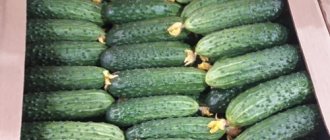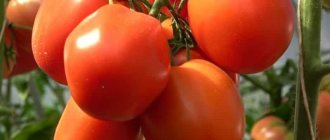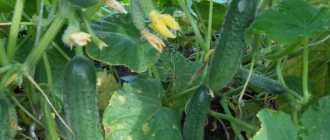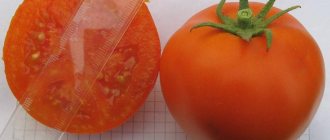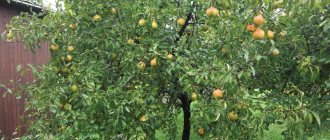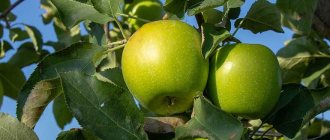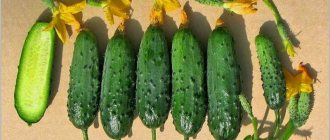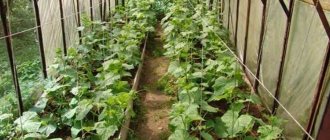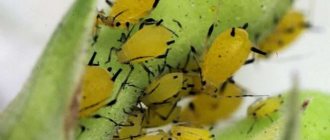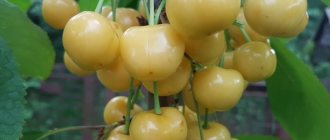April F1 is a tasty, juicy and crunchy hybrid of domestic selection. It can be grown even in cool regions of Russia and in countries with a similar climate. The taste is best revealed in salads and other dishes made from fresh vegetables.
| Landing location | Ripening time | Mode of application | Fruit length | Group | Fruit smoothness | Pollination method |
| Universal | Mid-early (46-55 days) | Salad | Long - from 15 to 20 cm | Hybrid | Slightly lumpy | Parthenocarpic |
History of selection
Cucumber April heterotic hybrid. This is indicated on the seed packet. Next to the name there is a designation - F1. This is the development of breeders of the Timiryazev Agricultural Academy, therefore the first name of the hybrid is TSHA 98.
In 1977, TSHA 98 was included in the State Register. A heterotic hybrid was obtained for growing in film shelters. The State Register states that it can be grown in heated winter greenhouses in all 7 light zones of the Russian Federation. At one time, the April cucumber underwent variety testing, and the hybrid was zoned in 24 regions.
It takes 45-50 days for a cucumber to begin bearing fruit. According to this parameter, it belongs to the group of early ripening cucumbers. The hybrid partially has parthenocarpy. Fruits can set without bee pollination. Practice has shown that the early harvest is higher if the first 2 flowers are pollinated.
Preparing seeds for sowing
To obtain high-quality seedlings, it is necessary to choose suitable planting material. There are varietal seeds and hybrids.
Hybrids (the packaging is marked with the abbreviation “F1”) are self-pollinating, disease-resistant, and are mostly intended for greenhouses.
- Before sowing, select large, full-bodied seeds.
- Then keep them in the potassium permanganate solution for 20 minutes.
- Then rinse with water.
- Instead of potassium permanganate, use a two percent solution of hydrogen peroxide or a solution of boric acid (half a teaspoon of powder per glass of water).
- To separate non-germinating seeds, they are germinated until roots 0.5 cm long appear, placing them in a humid environment. For this, wet gauze or cloth folded in 2-3 layers, cotton wool, and sawdust are also used.
If you plan to plant seedlings in open ground, it is advisable to harden the seeds. Soaked seeds, placed in a damp cloth, are stored in the refrigerator for two days at a temperature of 0 to 2 degrees. After hardening, planting is carried out.
Description of the cucumber variety April F1
Cucumber April F1 is a first generation hybrid. This means that it is obtained from crossing two varieties and combines the best qualities of the parent lines. Therefore, the April cucumber is resistant to adverse weather conditions and is highly productive.
The April cucumber F1 is parthenocarpic and produces mainly female flowers, which makes it possible to grow the crop in greenhouses and indoor conditions. Also suitable for growing in open ground, in film tunnels. Gives an early and friendly harvest. Shows long fruiting. It has early ripening periods - 40-45 days from emergence. The purpose of the fruit is universal.
An important feature of the April cucumber variety is that the plant has weak branching and produces few side shoots, which does not require pinching and pinching. Can be grown without a garter. The main stem is long, the leaves are large.
External indicators of the bush
The bushes are compact and form an average number of vines. Side shoots of determinant type. Self-regulation of growth is typical for them. Female flowering type.
Description of fruits
The April cucumber variety is distinguished by dark green fruits. Their length is 15-25 cm. The surface of the fruit is ribbed with slight fluff. The shape of cucumbers is cylindrical. This hybrid, together with the Zozulya variety, received first place at an international exhibition in terms of taste.
The peculiarity of April cucumbers is that when overripe they do not become bitter and do not overgrow. Also, the variety is not prone to yellowing.
The weight of one fruit varies between 200-250 g.
Taste qualities of cucumbers
The characteristics and description of the April cucumber variety indicate that it is genetically devoid of bitterness. Received high praise for its taste at an international exhibition. When growing, it is important to remove the fruits in time so that they do not overgrow, which makes their skin thicker. The length of the ripe fruit is 15-25 cm, weight is 200-250 g. The shape is elongated, cylindrical, the surface is coarsely tuberous. The skin is tender. The fruits are well suited for fresh consumption, canning and pickling.
Use of fruits
This hybrid produces universal fruits that are good for eating raw, but also suitable for making preparations. Convenient for preparing marinades and pickles. Fresh cucumbers can be stored for no longer than a week in a cool place. Hybrid greens are suitable for sale.
Is it possible to preserve April cucumbers?
The description of the April cucumber variety states the possibility of canning them. But the length of ripe fruits may not always be suitable for pickling. For preservation, medium and small cucumbers with black thorns are most often used. April cucumber with white thorns is more suitable for fresh consumption.
Advantages and disadvantages
Pros:
- early ripening;
- good yield;
- excellent taste;
- attractive appearance;
- the fruits are not bitter;
- resistance to hot and cool climates;
- the flowers are self-pollinating, so the plant can bear fruit well in a greenhouse;
- ease of care;
- high immunity and resistance to most diseases.
Minuses:
- short period of fruiting (about a month);
- vulnerability to white rot.
Characteristics of April cucumbers
The plants are represented by compact bushes due to their average branching and determinant side shoots, which are characterized by self-regulating growth. The height of the central stem does not exceed 2 m. The leaves have characteristic serrated edges. The color is intense green. Female flowering type. The hybrid is classified as parthenocarpic, which does not require insects for pollination. However, their participation increases productivity by up to 30%.
The hybrid is early ripening: the period of fruit ripening after emergence or planting of seedlings occurs on the 45-50th day. Fruits at technical ripeness have the following parameters:
- length – 15-22 cm;
- diameter – 4-4.5 cm;
- weight – 200-250 g;
- cylindrical shape;
- green, dense peel, covered with medium-sized tubercles with white spines and dark, short stripes;
- sweet pulp with intense aroma and small seeds.
“April F1” is relatively resistant to root rot, cucumber mosaic virus, and ascochyta blight. He rarely suffers from cladosporiosis. But the hybrid is susceptible to white rot, as well as attacks by melon aphids, which very quickly colonize the shoots. Cucumber is tolerant to low temperatures. Unstable summer weather and sharp fluctuations in daily temperatures in spring and late summer have little effect on fruit set and yield. The latter after three weeks of fruiting is 10-12 kg/m². Additional pollination by bees extends the yield phase of the greens for another period of time - allowing you to increase productivity to 20 kg/m².
For your information! Zelentsy is used fresh; due to its shelf life and marketability, it is sold in grocery stores, and can also be preserved. However, due to the large size of the fruit, pickling in its entirety is possible only in bulk containers.
Resistance to low temperatures and drought
The hybrid has high resistance to low temperatures. Unstable summer weather and sharp fluctuations in daily temperatures in spring and August have little effect on fruit set and yield.
The April cucumber develops well in the temperature range of 20-22 °C, and does not suffer from short-term drops to 16 °C. Development stops if the soil cools to 10 °C. Seedlings take root faster if the soil is heated to 20 °C.
Resistance to pests and diseases
Apart from white rot, the April variety is otherwise resistant to disease. Pests also do not seriously affect this variety if proper crop rotation is used on the site and basic preventive measures are carried out.
Features of fruiting
Most of the harvest is harvested in the first month of fruiting. In greenhouses, yields are high - 7-13 kg/m². When pollinated by bees, the number of fruits is many times greater. The fruiting period is 1-1.5 months.
The hybrid has a salad purpose. The manufacturer does not recommend pickling or canning greens; they can be salted. They are quite large. Dimensions and other characteristics of the fruit:
- in the crossbar 4-4.5 cm;
- length 13-22 cm;
- weight 200-210 g;
- cylindrical shape;
- the surface is slightly tuberous;
- white thorns;
- the taste is satisfactory and good.
Cleaning and storage
On the 45th day after emergence, the first harvest begins. Since the hybrid produces consistent fruit, the greens are removed every two days or even daily. Due to the lack of tendency to overgrow or yellow, the fruits will be able to wait a little for the grower, but the intensity of ovary formation will decrease. Cucumbers are harvested in the morning or evening, when they are more elastic.
Remove the greens carefully, without pinching or tearing them off, but using sharp scissors. The stalk is left on the shoot to ensure long-term storage. After sorting, healthy fruits are sent to a cool place. When kept at a temperature of 5 °C, they can retain their presentation and taste for about 15 days. In room conditions - a maximum of 4. Before storing, cucumbers should not be washed so as not to damage the protective shell that protects them from rotting.
Growing cucumbers on a windowsill in an apartment in winter Growing vegetables or herbs on the windowsill of your apartment in winter is an interesting and exciting activity...
Features of planting April cucumbers
This variety likes to grow in greenhouse conditions - its fertility may decrease in open ground. According to the description, crumbly, sandy loam soils and black soil are best suited for cucumbers. In order for Aprilsky's whip to receive more light and oxygen, it is tied to trellises or a dense, strong rope.
Landing dates
Cucumber seeds begin to be planted for seedlings in mid-April. The seedlings themselves are introduced into the soil exactly a month later - in mid-May. In a heated greenhouse, April f1 can be cultivated for the first time at the end of February - this way you can get 2-3 harvests per season.
When to plant seedlings
In most regions of Russia, cucumbers are planted in the first days of June, so seedlings are sown in early May.
Water the plants with warm water, best in the evening.
It is necessary that water does not fall on the leaves of cucumbers, as in the greenhouse this leads to increased humidity and the appearance of various infections.
Watering can be combined with fertilizing, which is mandatory for cucumbers. If the soil was well filled with organic matter, then the dose of nitrogen components can be reduced. In the second period of the growing season, when greens will form, more potassium and phosphorus additives are introduced into the plant “menu”.
On a note! Watering cucumbers with nettle infusions, as well as ordinary wood ash, is effective.
It is recommended to carry out the first feeding no earlier than 14-16 days after planting the seedlings. In total, cucumbers are fed at least five times during the season. Fertilizing not only helps to increase productivity, but also improves plant immunity. In addition to traditional organic matter: mullein, bird droppings, peat or ash, they also use “mineral water”: urea, potassium sulfate, superphosphate.
For foliar feeding, we recommend boric acid, solutions of complex fertilizers, ammonia or iodine.
It is also necessary to control the temperature at which cucumbers are grown.
This is especially important for plants grown in greenhouses. Despite the heat-loving nature, extreme heat is also contraindicated for this vegetable crop, as is cold weather.
Optimal mode: during the day +25-26ºC, at night +22-23ºC. If the temperature is below +18ºC, or above +38ºC, the plant will not form ovaries. At +10ºC, the growth of cucumbers stops.
The April hybrid responds normally to worsening weather conditions (although, of course, the harvest will be slightly smaller), as it is cold-resistant.
Zelentsy are removed regularly, at least two to three times a week. Hybrid cucumbers store well, do not turn yellow for a long time, and retain an excellent presentation.
Site selection and soil preparation
For “April”, sunny areas protected from the wind are suitable. The optimal indicator of soil acidity is neutral. If the soil is heavy, it is lightened with sand, increasing aeration qualities. To prevent stagnation of moisture in the roots, groundwater should lie as deep as possible. The best predecessors are peas and cabbage; all nightshade crops are acceptable. Cucumbers should not be placed after pumpkin vegetables. Soil fertility and looseness are improved during autumn soil preparation:
- adding compost and superphosphate – 6 kg and 30 g per m² of area;
- digging on a spade bayonet;
- removal of weed residues.
Pre-sowing seed preparation
Planting material for “April f1” cucumbers is distributed by several seed companies and agricultural firms. Original seeds are produced by selection and seed production. The quality and quantity of seeds must always comply with GOST R 52171-2003. Preplanting preparation of seed material consists of the following sequential activities:
- sorting and selection of the highest quality seeds;
- process of heating seeds;
- preventive treatment or disinfection of seeds;
- germination of seed material followed by hardening.
For disinfection, potassium permanganate is most often used, the crystals of which should be diluted in warm water at the rate of 10 g per liter of water. The seeds are placed in such a slightly pink solution for 30 minutes, after which the seed material is thoroughly washed under running water. For dry disinfection, you can use drugs such as NIUIF-2 or TMTD. It is advisable to carry out additional treatment of seeds with special biostimulants that improve growth and accelerate the development of plants.
Planting seeds
Seeds for seedlings of the variety are planted in spacious pots or boxes with a volume of 400 ml. They are filled with a nutritious soil mixture: soil, coconut substrate and humus. Cucumbers are introduced to a depth of 1.5-2 cm, 2-3 seeds per hole. The containers are exposed to the sun; on cloudy days, April f1 is illuminated with lamps. Water thoroughly every 3 days.
Agrotechnics of cultivation and care
Seedlings should be planted a month before planting the bushes on the ridges - around April, early May. Before this, the seeds undergo preparation - sorting and selecting quality specimens, heating and disinfection for 30 minutes in potassium permanganate (10 g/l of water), washing them with clean water, and germination. Planting material is sown into the soil no deeper than 1.5-2 cm.
It is recommended to prepare beds for the April F1 cucumber hybrid in the fall. Rotted manure, a little superphosphate and fertilizers containing potassium are added to the soil. After this, the soil is dug up. If the soils are acidic - and cucumbers do not like them - then in the autumn ash, lime or dolomite flour is added to them.
In the spring, the soil must be fertilized with nitrogen-containing fertilizers, and compost or humus must be placed in each hole before planting the sprouts. The April cucumber hybrid grows best on loam and light soils.
Planting of seedlings grown in seedlings in the ground is carried out when they reach the age of 20-25 days. This usually happens in mid-May. The planting pattern is simple - two rows with a distance of 50-70 cm between them. The holes are located 30-40 cm apart from each other. Thus, the planting density will not exceed the recommended values - 2.5-3 bushes per 1 m2.
They are sown in open ground no earlier than the soil warms up to 15-20 degrees during the day, and at night the temperature is not lower than +8 degrees. Holes or grooves are created for planting material, which are filled with a mixture of peat, humus, sand and mineral fertilizers, and then spilled with warm water. The seeds are immersed in them by 1.5-2 cm, mulched with peat or rotted manure, after which the ridge is covered with film. You can sow seeds in a greenhouse around the beginning of May.
It is better to plant the April F1 cucumber hybrid in protected soil using a trellis method. But you can equip it with a cucumber bed and window sills. In the latter case, it is better to plant 3 seeds in wide pots. The central shoots are pinched at the top of the trellis, the lateral ones - above the 3rd or 4th node. At home, plants are also pinched.
Caring for the hybrid April F1 consists of periodically loosening the soil around the plantings, watering, weeding and fertilizing. It is better to water after sunset with warm water.
Organic and mineral fertilizers are applied no more than once every 7-10 days after watering. Cucumbers prefer certain mineral fertilizers. For example, these hybrids respond well to feeding with ammonium nitrate (10-15 g), ammonium sulfate (17-25 g), potassium chloride (10-20 g) and superphosphate (20-30 g). This amount is calculated per 1 m2 of planted soil. If the soils on which cucumbers are grown are sandy, then it is worth applying more nitrogen-containing fertilizers, and for floodplains it is better to increase the dose of potash.
For the first time, fertilizers are used no earlier than 3-5 days after planting the bushes in the ground. This time it is worth adding ammonium nitrate (18-20 g/m2). This feeding will be especially relevant if the ridges are located on light soils.
During the formation of vines, cucumbers readily respond to potassium fertilizing - approximately 20 g of potassium nitrate with the addition of superphosphate (25-30 g), which is applied per 1 m2. The same option is used during hybrid fruiting.
If there was a long period of cool weather, and then warm weather set in, it is recommended to feed the hybrids with saltpeter. It is embedded to a depth of about 6-7 cm in the soil at a distance of about 7 cm from the bushes and watered with water.
Root feeding is especially important if it is cool outside. Fertilizers are applied for the first time when the plants have their third true leaf. Here they use 10-15 g of superphosphate composition and 3-8 g of potassium chloride per 1 m2. The second time, root dressing is applied deeper - 10-12 cm into the soil and at a distance of 10-15 cm from the hybrids.
Organics are also used for hybrids. These can be solutions of mullein (1:4.5), chicken manure (1:10 or 15). Such fertilizers should be infused for several days, after which 1 part of the composition is diluted in 10-15 parts of water. The mixture is applied after watering or rain.
- until 5 true leaves appear - 20-22 degrees during the day and 16-18 degrees at night;
- during the flowering period - 26-28 degrees during the day and 24-26 degrees at night;
- during fruiting - 28 degrees during the day and 18-20 degrees at night.
The harvest must be collected in a timely manner. At the same time, the bushes are inspected for the presence of deformed or diseased fruits.
It is important to remove them immediately to prevent the infection from spreading further.
Caring for April cucumbers
Care is simplified if crop rotation is observed in the garden. In the greenhouse, the soil is renewed every 2 years. Here and there, soil fertility is regularly restored. Green manure is sown, organic matter and mineral fertilizers are added.
Watering and fertilizing cucumbers
The hybrid does not cause much trouble in caring for it. April plant does not like frequent watering; excess moisture can lead to rotting of the roots. Water the cucumbers generously every 3 days.
Plants are also fed infrequently:
- After three to four leaves appear on the main stem.
At this stage, it is better to use organic matter, for example, a slurry solution. The ratio with water is 1:20. After processing organic matter, all kinds of beneficial bacteria and microorganisms are formed in the soil, which help plants develop properly and produce good yields. - At the beginning of flowering.
There are 2 types of feeding: root and air. For the root, you can use ash in the amount of 1 tbsp. for 1 liter of water. When carrying out air feeding, you should use superphosphate. Very well grown cucumber seedlings react to a mixture of water with a small amount of superphosphate - Fruiting.
During this period, the plant is fed once a week. Cucumbers need nitrogen fertilizers such as urea, ammonium sulfate, ammonium nitrate and others. Fertilizers are used according to the instructions on the package. Urea is a universal fertilizer, used on all types of soils
Watering
Water with warm water after sunset. When it gets cold, they stop. High humidity at low temperatures causes fungal diseases. In hot weather, if there is no rain, cucumbers can be watered every day. Standard scheme:
- in hot weather - once every 2 days;
- if it’s cool - 1 time every 5 days.
Top dressing
The April cucumber responds well to organic feeding. Add 1 liter of mullein infusion to a bucket of water. 0.5-1 liter is enough for one plant. Feed after scheduled watering. The soil is mulched. Other fertilizer compositions:
- ammonium nitrate - 1 tbsp. l. for 10 liters of water, consumption - 10 l/m²;
- superphosphate - 2 tbsp. l. for 10 liters of water, consumption - 10 l/m²;
- potassium nitrate - 1 tbsp. l. for 10 liters of water, consumption - 10 l/m².
Potassium root feeding is needed during the flowering and fruiting period. Nitrogen is necessary during active growth of vines. Phosphorus - throughout the growing season. During the season, the hybrid is fed 3-4 times.
Loosening the soil and weeding
The soil is loosened after each watering. Loosening prevents the formation of a surface crust, which prevents oxygen from reaching the roots. Weeds are removed regularly. Both measures become unnecessary after the bed is covered with mulch.
Hilling
Sprinkling with soil protects from heat and frost, supports the bush and promotes free air circulation. The first time the cucumber is hilled is 2 weeks after planting. They are filled to the top with soil. Subsequent hillings of April are carried out after heavy rainfall, so that the area does not become crusty, or on dry days, to avoid overdrying and burns. We must not forget about periodic loosening of the row spacing of the variety - once every 3 weeks, to the depth of a shovel.
Stepsoning
When the 8-9th leaf appears, the plant begins to form. Be sure to blind the 3 lower nodes. In the next 5 nodes, 1 ovary and 1 leaf are left. All other side shoots, starting from the 9th node, are pinched behind the 3rd leaf. Pinching helps normalize the harvest.
How to shape and tie April cucumbers
In a greenhouse, the April cucumber is grown on a vertical trellis. The height from the soil to the top wire is 1.8 m. The plants are tied up on the day of transplantation. Use pieces of twine 2.5 m long. A free loop is attached under the 3rd leaf.
When the central shoot reaches the top wire, it is wrapped around it twice and lowered down. The crown of the main stem is pinched, the growing points are left on the 2 upper braids.
In the garden, the hybrid can be grown and formed on different types of vertical beds:
- cone-shaped trellis;
- frame trellis in the shape of a hut;
- trellis in the form of a flat lattice.
Garter
The vines are tied up so that it is convenient to care for the cucumbers. There are 3 main methods:
- Vertical. One end of the rope is wrapped around the main trunk, the other is tied to a crossbar located 2-3 m above the ground.
- Horizontal. Trellis are stretched horizontally over the cucumbers at regular intervals. The side stems are tied to them.
- Grid. They build or buy a structure in the form of a grid and install it vertically. The vines with tendrils are directed onto the net, and the plant itself weaves along it.
Stepsoning
Due to moderate branching, the bush may not be formed. But vegetable growers plant the plant in order to obtain large yields. Excess shoots are removed up to 4 leaves. The procedure is carried out regularly as soon as new stepsons are formed.
Formation of the main lash
Cucumbers of the April variety need to be blinded only on the first four leaves. With the subsequent growth of the plant, the main lash will form independently. Shoots, inflorescences and fruits are removed from each internode. The tendrils growing between the leaves are also removed. Blinding of a cucumber is carried out in order to increase the yield of the plant and strengthen its root system.
Video: how to form a cucumber stem
Table: what should be the room temperature at different stages of growing cucumbers
| Transplanting seedlings | +20+22 оС (in the evening 16–18 оC) |
| Flowering cucumbers | +25+28 оС |
| Fruiting | +25+30 оС |
| Suspension of plant growth | +15 оС |
| Stopping the growth of cucumbers | +10 оС |
| Plant death | +8 оС |
Soil and fertilizing
The soil should always be moist, warm, light and maximally saturated with humus. Rotted leaves, sawdust, humus, compost, crushed peat mixed with garden topsoil and sand will create a familiar environment for cucumbers. Organic matter must be supplemented with mineral additives: ash 200 g per 1 m², complex granular fertilizers according to the instructions. The root depth of cucumbers is shallow, so 30 cm of this soil mixture is sufficient.
Every 10-14 days the hybrid needs feeding. April responds well to alternating organic (infusion of mullein or bird droppings) and mineral fertilizers.
Harvesting
The April cucumber is harvested, according to the description, in early to mid-July. The greens of this variety ripen together, so the gardener should be careful and cut them off before the skin begins to thicken and turn yellow. The best time to harvest is in the evening, at sunset, after watering. April greens are cut with scissors, leaving the stalk on the shoot. A week before harvesting the first cucumbers, you must stop any feeding.
At the beginning of fruiting, the greens are collected every other day so that they do not overgrow. The optimal size is 15-20 cm. In August, fruit formation is slower because it is cool at night. At this time, cucumbers are harvested once every 2 days.
It is better to pick cucumbers for pickling in the morning when they are cool. The April salad variety, but greens that have not had time to be eaten fresh are sent for processing. They are salted, pickled, and made into delicious winter snacks.
Immediately after harvesting, the variety is stored in a cold place. Store cucumbers wrapped in plastic, but not tied - air should flow to them freely. You cannot wash them before this - otherwise the protective layer on the skin will be washed off. With proper storage, April will remain fresh for up to 2 weeks.
How to collect and store
The variety is excellent for pickling and pickling. The fruits of the April cucumber ripen within one month, quickly and early. Therefore, the harvest does not last long. It is better to remove the greens in the morning, before they are elastic and have not had time to heat up from the sun. Remove the fruits carefully, without damaging the vines.
Cucumbers are convenient to use for pickling and pickling. For salads, it can be used for a short period of time, since fruiting ends quickly. Fresh fruits without processing can be stored in a cold place for no more than a week.
The variety is interesting for gardeners who grow vegetables for the market. This is facilitated by the friendly simultaneous ripening of fruits, a large number of which are convenient for sale. For personal use, you can use April together with other varieties.
profermu.com
Possible problems and recommendations
Sometimes when growing cucumbers you may encounter the following problems:
- Fall of the ovary. The fruits, before they have time to grow, turn yellow and crumble, which may be due to low air temperatures, very high humidity or lack of fertilizing. Adjust these indicators and everything will work out.
- Yellowing and drying of leaves during plant growth. The problem is due to a lack of nitrogen, which can be corrected by fertilizing with any nitrogen-containing fertilizer.
- Wilting of fruits and shoots of the plant. This may be a sign of damage to the root system of the plant, which can no longer be cured - the plant will die.
- Lack of ovary on many flowers. The reason is extreme heat, excess nitrogen. Adjust your fertilizing schedule to avoid this problem.
Diseases and pests
The April variety boasts excellent immunity. However, it still needs disinfecting sprays, especially before planting in the ground and at the beginning of flowering. The safest means of combating viruses on cucumbers are ash, potassium manganese and saline solution.
Diseases
April is resistant to various viruses and root rot. However, there are a number of diseases that are dangerous for cucumbers:
- White rot.
This disease affects greenhouse plants, including cucumbers. To prevent the appearance of white rot, it is necessary to monitor the humidity in the greenhouse. Excess moisture, as well as excessive density of the planted area, contribute to the active development of the fungus. To prevent the disease, it is enough to periodically ventilate the room, reduce the amount of watering and thin out the plants. If cucumbers are lightly infected, rot can be combated. The affected parts of the plant are removed, the cut is sprinkled with coal or lime. To restore cucumbers after illness, you need to carry out air feeding. For this purpose, fertilizers containing copper sulfate and urea are used. For 10 liters of water you need to take 2 g of vitriol and 1 tsp. urea. White rot appears on cucumbers due to high humidity in the greenhouse - Late blight is a fungal disease.
Causes: high humidity, sudden temperature changes, poor air ventilation. The appearance of this fungus becomes noticeable by brown spots on cucumber leaves. To treat plants, preparations containing copper are used. For example, you can treat the bushes with copper sulfate (1% -3% solution). Late blight leads to the death of leaves on the cucumber lash - Alternaria blight.
An infectious disease characteristic of greenhouse plants. Occurs at high humidity and air temperature from +26 ° C. Brown spots in the center and along the edges of the leaves indicate Alternaria blight. Cucumbers are sprayed with Bordeaux mixture (1%) or copper oxychloride (0.4%). Alternaria blight begins to appear as brown spots on the leaves.
White rot
The fungus affects all parts of April f1 - leaves, greens and stem. The development of the disease is provoked by excess moisture and too high planting density. Appears as whitish, pubescent spots. As soon as signs of white rot appear on the cucumbers, the damaged parts of the plant are removed. After this, the places where they grew are treated with a solution of lime or coal. The health of the variety can be restored by aerial feeding with copper sulfate.
Alternaria blight
The virus often affects cucumbers growing in greenhouses. Its appearance is signaled by small light beige putrefactive marks on the leaves. Most often, the cause of the spread of the disease is high humidity at high air temperatures - the “greenhouse effect”.
Treatment with a solution of copper oxychloride or Bordeaux mixture will help cure infected April bushes. For prevention, the cucumber is sprayed with an ash solution.
Aphid
This insect pest spreads in areas where weeds are not kept clean enough. You can guess that the April f1 variety is affected by aphids by stunted growth, curling and yellowing of the leaves.
A solution of mustard powder, soda, or wood ash with soap is suitable as an easy and safe remedy against aphids on cucumbers. If the plants of the variety are severely damaged, you will have to use chemicals such as Oxychoma, Inta-vir, or Topaz.
Prevention: pests and diseases
Crop rotation is the main prevention of any vegetable diseases. In the greenhouse it is replaced in another way. Renew the soil. They bring it from the beds where onions, legumes, and cabbage previously grew.
For symptoms of white rot, use a composition of water (3.5 l), whey (1.5 l) and copper sulfate (0.5 tsp) or drugs:
- "Oxychom";
- "Topaz".
They fight aphids with store-bought products: “Iskra”, “Aktofit”, “Aktara”. While there are few insects, the leaves are sprayed with an infusion of ash and soap.
How to plant correctly
For planting, seedlings or germinated seeds are used. Seeds for seedlings are sown in April a month before planting in the garden.
If the bush grows in a greenhouse, the seeds are planted to a depth of 1 cm. The distance between them is more than 30 cm, between the rows - 50 cm. The width of the ridge is 1 meter. This distance between the bushes is convenient for care; the plants do not interfere with each other’s development and do not shade their neighbors.
If planted in open ground, the seeds are planted 2 cm deep. The distances between them are similar to those planted in a greenhouse.
For planting April, germinated seeds or seedlings are used.
Like all garden crops, basic care includes watering, loosening, fertilizing, protection from harmful insects and diseases.
High temperature is also undesirable. The heat causes the ovary to fall off, a new one does not form, and the fruits begin to taste bitter. Humidity is no less important; cucumber vine does not like dry air.
A dry crust on the soil delays the flow of air to the roots, the plant begins to wither, leaves and fruits fall off. Loosening provides access to air, and when watering, penetration of moisture into the soil.
Without nutrition and fertilizing there will be no development, the harvest will be low. They begin to feed cucumber seedlings two weeks after planting. It is necessary to use a complex fertilizer, which should include nitrogen, potassium and phosphorus.
First add more nitrogen to build up the mass. Next, you need to fertilize every week. The cucumber grows quickly, bears fruit amicably and requires a lot of nutrition.
Organic matter and complex mineral fertilizers can be applied as top dressing.
He loves organics. Compost, rotted manure, and diluted bird droppings are his favorite fertilizers. But mineral supplements, especially microelements, are never superfluous.
When applying fertilizers, it is important to maintain the correct dosage. These plants absorb all the elements they receive well; an overdose will lead to an increase in nitrates in the fruits and the appearance of ugly cucumbers
It is necessary to remove weeds from the beds in a timely manner. Not only do they take moisture and nutrition from the plant, it is a convenient place for the development of diseases and the life of pests. By removing weeds, you solve these three problems.
There are many means of protecting crops without harm to people and birds. Fitosporin, a microbiological preparation based on living fungi, is effective in combating bactericidal plant diseases. The drug Fitoverm is used to control pests.
Another condition for successfully growing cucumbers is the formation of a bush. The plant is best grown vertically. The central stem is pinched at the height of the trellis, 5-6 nodes are left on the side stems, the higher the shoot is located, the longer it is made.
For a good April harvest, it is necessary to form a bush
There are errors when forming. When growing bee-pollinated varieties, pinch out the central shoot after the 5th node. In the April hybrid, the main fruits are formed on the main shoot. Don't forget this.
The variety is resistant to all major cucumber diseases. The main problem for him is white rot. This is a fungal disease that develops from spores that live in the ground. First, the root part of the plant becomes diseased, then the rot rises up the stems.
Maintain the microclimate in the greenhouse, avoid high humidity and low temperature. To prevent disease, treat the holes with potassium permanganate. When rot appears, apply a mixture of potassium permanganate and chalk to the affected areas. Remove damaged shoots.
